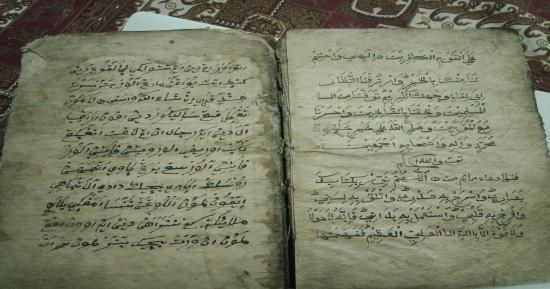The minimum standard requirements of the Indonesian Journal of Arabic Studies must be
Abstract: The Abstract should be informative and completely self-explanatory, briefly present the topic, state the scope of the experiments, indicate significant data, and point out major findings and conclusions. The abstract should be 150 to 250 words in length. A complete sentence, active verbs, and the third person should be used, and the abstract should be written in the past tense. Standard nomenclature should be used and abbreviations should be avoided. It should be self-contained and citation-free. The abstract should be in English and Arabic.
Keywords: Keyword1, Keyword2, Keyword3, Keyword4, Keyword5. (5 to 10 keywords that will provide indexing references should be listed.)
1.Introduction
The Introduction should provide a clear statement of the problem, the relevant literature on the subject, and the proposed approach or solution in such a manner that should be intelligible to scholars and researchers from a broad range of scientific disciplines. This section should be succinct, with no subheadings. The introduction consists of an explanation of the research problem that will be revealed, the results of previous studies that have discussed the theme you wrote, the distinction between your research and previous studies, the novelty of the research, and the research purposes.
2.Methods
The Methods consist of research design, population, sample, data source, data collection technique, and data analysis technique. It is written in paragraph form. Methods should be complete enough to allow experiments to be reproduced. However, only truly new procedures should be described in detail; previously published procedures should be cited, and important modifications of published procedures should be mentioned briefly. Capitalize trade names and include the manufacturer's name and address. Subheadings should be used. Methods in general use need not be described in detail.
3. Results and Discussion
The Results and Discussion should be presented with clarity and precision. The results should be written in the past tense when describing findings in the author(s)'s experiments. Previously published findings should be written in the present tense. Results should be explained, but largely without referring to the literature. Discussion, speculation, and detailed interpretation of data should not be included in the results but should be put into the discussion section and also should interpret the findings in view of the results obtained in this and in past studies on this topic. State the conclusions in a few sentences at the end of the paper. The Results and Discussion sections can include subheadings, and when appropriate, both sections can be combined.
The results of the research can be supplemented with tables, images, or graphs to clarify the results of the research. Avoid presenting similar data in separate tables. All tables, images, and graphs must be centered and numbered sequentially

Figure 1. This is figure 1. All figures must be aligned and centered.
Table 1. This is Table 1. All tables must be aligned and centered.
Colomn1 | Colomn1 | Colomn1 |
Value 1 | Value 2 | Value 3 |
Value 4 | Value 5 | Value 6 |
Value 7 | Value 8 | Value 9 |
For qualitative research, the results section contains detailed sections in the form of sub-topics that are directly related to the focus of research and categories. The discussion in the article aims to: (1) answer the problem formulation and research questions; (2) show how the findings were obtained; (3) interpret findings; (4) link research findings with established knowledge structures; and (5) raising new theories or modifying existing theories. This section of the discussion must contain the benefits of the results of the study, not the repetition. The analysis must answer the stated gaps.
4.Conclusion
This should clearly explain the main conclusions of the work highlighting its importance and relevance. And also the conclusions include limitations, suggestions, and research implications.
References (Example)
This should clearly explain the main conclusions of the work highlighting its importance and relevance. And also the conclusions include limitations, suggestions, and research implications.
References (example)
Bardawil, Fadi A. Revolution and Disenchantment : Arab Marxism and the Binds of Emancipation. Duke University Press PP - Durham, 2020. https://doi.org/10.1215/9781478090274.
Feist, Jim. Significance in Language : A Theory of Semantics. Taylor & Francis, 2022. https://doi.org/10.4324/9781003259381.
Orsini, Francesca, Neelam Srivastava, and Laetitia Zecchini, eds. The Form of Ideology and the Ideology of Form : Cold War, Decolonization and Third World Print Cultures. Open Book Publishers PP - Cambridge, 2022. https://doi.org/10.11647/obp.0254.
Richardson, Kristina. Difference and Disability in the Medieval Islamic World : Blighted Bodies. Edinburgh University Press, n.d. https://library.oapen.org/bitstream/id/abde92be-f4c7-4693-bc85-5914353273f2/642704.pdf.
Sazonov, Vladimir, Holger Mölder, and Peeter Espak, eds. Cultural Crossroads in the Middle East : The Historical, Cultural and Political Legacy of Intercultural Dialogue and Conflict from the Ancient Near East to the Present Day. University of Tartu Press PP - Tartu, 2019. https://library.oapen.org/bitstream/id/3b0f3d72-300f-435a-a6d7-b5aad2db3fb5/978-9949-03-176-4.pdf.
Simpuruh, Indrayani, Murni Mahmud, Kisman Salija, and Abdul Halim. “Code-Crossing in Indonesian EFL Classroom Interaction.” International Journal of Language Education, December 30, 2020. https://doi.org/10.26858/ijole.v4i3.13969.
Ziolkowski, Jan M. The Juggler of Notre Dame and the Medievalizing of Modernity : Volume 4: Picture That: Making a Show of the Jongleur. Open Book Publishers, 2018. https://doi.org/10.11647/OBP.0147.
Note :
References should be listed at the end of the paper in alphabetical order. Articles in preparation or articles submitted for publication, unpublished observations, individual communications, etc. should not be included in the reference list but should only be mentioned in the article text (e.g., Ahmed, Syekh Nurjati State Islamic University of Cirebon, Indonesia, individual communication). Authors are responsible for the accuracy and completeness of their references and for correct text citation. Writing citations and bibliography should use application management references such as Mendeley, Endnote, Zotero or applications in Ms Word.
Writing citations and bibliography using Chicago Manual of Style 17th edition (Full Note) by using in footnote writing technique. Expect a minimum of 25 references primarily with minimum 60% to journal papers of the last 10 years. Wikipedia, personal blog, and non-scientific websites are not allowed to be used as reference.










.png)



_(3).png)
